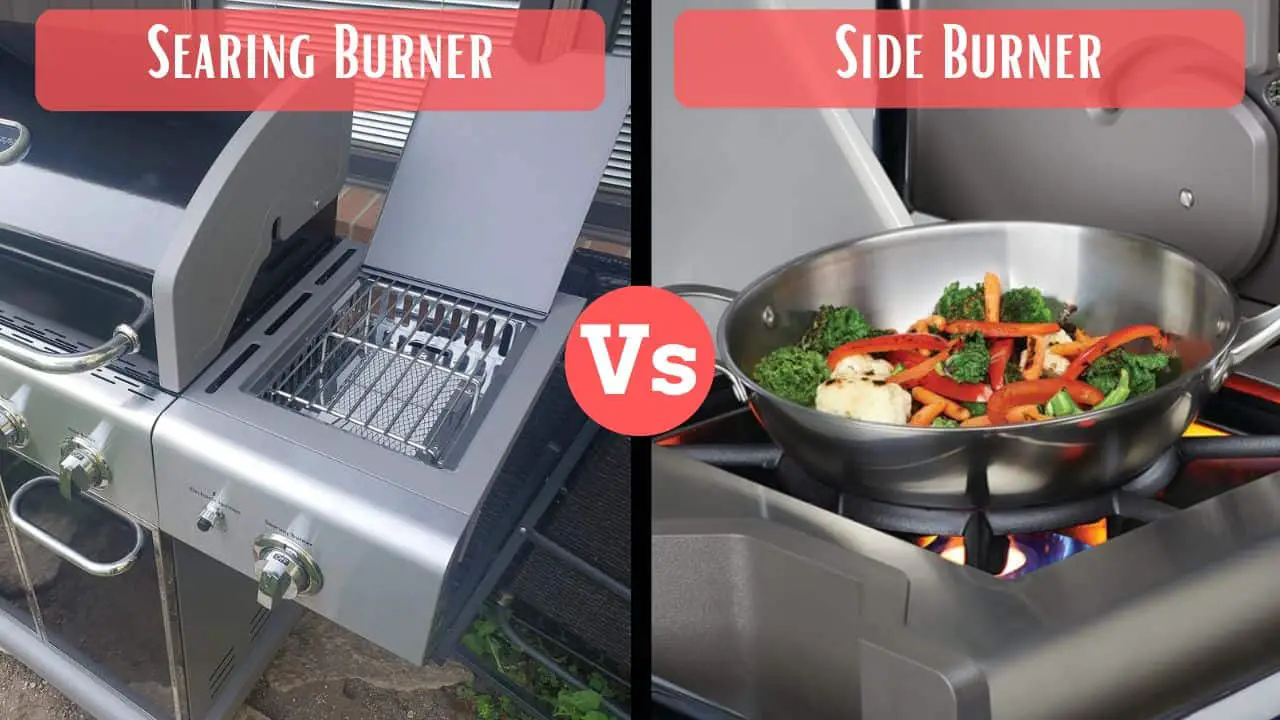Grilling is my passion—in fact not to brag, but I think I’ve pretty much mastered the art owing to decades of experience.
I’ve used several grill types over the years—small, big, propane, natural, charcoal grills, and most recently—my all-time favorite infrared grill.

Table of Contents
- 1 What is an Infrared Grill?
- 2 How Does an Infrared Grill Work?
- 3 Brief History of Infrared Grills
- 4 Is Infrared Grilling Safe?
- 5 What Can be Cooked with an Infrared Grill?
- 6 Different Types of Infrared Grills
- 7 Benefits of Using an Infrared Grill
- 8 Disadvantages of Infrared Grills
- 9 How Much Temperature Can an Infrared Grill Achieve?
- 10 When to Use an Infrared Grill?
- 11 Why Does my Infrared Grill Smoke?
What is an Infrared Grill?
You’ve probably heard about infrared technology—also known as thermal detection systems that basically converts thermal energy into an electronic signal.
But what about infrared grills? This type of grilling appliance is still somewhat of a mystery to even a few seasoned grillers.
Just as the name would suggest, infrared grills are powered by infrared technology that heats the meat and not the air.
And since infrared technology only heats the meat and not the air in the surrounding, it doesn’t affect the moisture of the meat, but in fact allows the food to retain 35 percent of its natural juices, resulting in tender and juicy results.
How Does an Infrared Grill Work?
You’ve probably walked barefoot, and felt the hot sand against your feet at the beach. Well, that’s infrared heat at work!
The sun emits infrared energy waves towards the sand which gets absorbed and heats up the sand, which is what you feel on your feet.
When it comes to infrared grilling, the same theory applies, where the heat waves are emitted by a hot object that’s been preheated by a natural gas or propane-powered heat element.
The source of heat in an infrared grill, that is the hot object inside an infrared grill is typically a piece of ceramic, glass, or steel.
Brief History of Infrared Grills
Infrared technology is as old as the sun and earth, and basically entails heating a surface such as bricks, ceramic, rocks or glass, and then grilling with the radiant heat emitted by that surface.
When it comes to grilling, infrared heat is the new kid on the block and was first used by Bill Best in the first patented infrared burner—founder of the Thermal Engineering Corporation.
Fast forward to the 1980s, Best—a perpetual inventor and backyard griller added a ceramic infrared burner to his personal barbeque grate and discovered a quicker cooking process that produced succulent fast-cooked foods.
This technology when first incepted was too expensive for most home chefs and was mostly adopted for commercial purposes such as in leading steakhouses and restaurants.
In an effort to attract backyard cooks, many manufacturers including the company founded by Bill Best started manufacturing affordable electric and gas-powered infrared grills.
Infrared grill sales have hit the roof ever since then with more than a whopping 15 million infrared grills shipped to North American retailers in 2010 alone.
Is Infrared Grilling Safe?
There’s often big debate whether infrared grilling is safe, and here’s the lowdown. Infrared grilling uses electromagnetic technology to cook your food—the same technology used in microwaves.
High energy forms of electromagnetic radiation such as X-rays may pose a cancer risk, but infrared grills just don’t have that much power to alter or damage DNA.
Infrared grills are fitted with an IR element that’s responsible for radiating heat, and nothing more.
Adding to this, it doesn’t produce harmful radioactive rays when heated, but only evenly distributes heat across the cooking surface.
Infrared grills don’t alter the internal structure of the food, because they don’t use radioactive rays to cook.
Even though infrared grilling is safe, there are a few precautions you should take such as being careful when cooking due to the intense heat generated.
Furthermore, if your infrared grill isn’t working properly, you should not try to fix things yourself, but rather call professional help, as some inner components can cause electric shock, even when unplugged.
What Can be Cooked with an Infrared Grill?
Infrared grills produce an intense amount of heat, which is why they are best for cooking certain types of food items.
While solid and dense meats can hold up to the extreme heat of infrared grills, food items such as sausages, stuffed vegetables, and delicate fish can be harder to cook, and in worse cases can break apart easily.
You can however still smoke fish and meats on your infrared grill, as long as you take the necessary steps to prep the meat first.
First, pat your meat or fish dry before tossing it on your infrared grill. Patting the food items removes the excess moisture, which if left on the surface tends to steam the meat or fish rather than searing it.
If the meat or fish are stored in your refrigerator before cooking, you should remove the food items, and bring them to room temperature before infrared grilling.
Grilling food items that you just removed from the refrigerator will produce a protein that’s both tough and chewy.
Different Types of Infrared Grills
Shopping for the best infrared grill can be a bit overwhelming for two reasons—there are a plethora of brands to choose from, and each utilizes a different cooking system.
3 Types of Infrared Burner Cooking Systems
1. Ceramic Infrared Burner System
A ceramic infrared burner system features a stainless steel burner that’s topped with a ceramic plate. According to the pioneers of the infrared burner concept—TEC, the first plates for infrared burners were made from ceramic.
This ceramic plate has thousands of microscopic holes in it that produce many tiny flames across the grill’s cooking surface for intense, even heat distribution.
The ceramic plate sits a few inches below the infrared grill’s cooking surface and emits between 600-1000°F temperatures.
Ceramic infrared burner systems feature a naked flame on the plate, hence can be prone to flare-ups.
2. Radiant Glass Panel System
A radiant glass panel system features a cooking surface that’s set directly over a radiant glass panel, and atop a highly durable stainless steel burner.
Radiant glass panel systems provide unmatched even heat distribution, and little or no flare-ups.
Adding to this, radiant glass panel burner systems can reach temperatures between 200 and 900 degrees, so while they can’t match the temperatures offered by ceramic infrared burner systems, the food cooked on them can be steakhouse quality searing.
3. Heat Emitter System
Heat emitter burner systems are usually found on cheaper infrared grills. They feature a stainless steel tube burner combined with a metal heat emitter panel.
Heat emitter systems can generate heat between 350 degrees to 650 degrees, and provide good even heat distribution with next to no flare-ups.
Heat emitter burner systems are easier to handle than other types of burner systems but do not deliver the same results as super intense, high heat infrared burners.
Benefits of Using an Infrared Grill
There are myriad benefits of cooking on infrared grills compared to their gas, charcoal, or electric counterparts.
1. Quick Preheat
Infrared grills can be preheated within two to three minutes, so you can get started with grilling quickly. Contrarily, electric and charcoal grills can take 15 minutes or more to preheat, which needless to say is a pretty long wait.
2. Even Heat
Infrared grills provide even heat distribution across the cooking surface, which greatly reduces the chances of hot and cold spots that’s usually is a big issue with charcoal and electric grills.
3. Faster Cooking
Infrared grills provide heat at extremely high temperatures, so your food cooks faster. Grilling with a charcoal grill however can be a daunting task, given that you first have to light the coals, and wait for them to reach the desired temperature, and then tend to the coals during the cooking process.
4. Food Tastes Better
Given that infrared grills allow your food items to retain up to 35 percent of their natural juices, you get nothing less than tender and juicy results.
Comparatively, foods cooked on gas or electric grills do not retain much natural juices, but there are a few steps you can take to get tender and juicy results.
5. Steakhouse Quality Searing
If you grill steaks often, and want to achieve steakhouse quality, infrared grills won’t disappoint, given their ability to sear at high temperatures—something electronic and charcoal grills fail to match.
6. Minimal Flare-Ups
With infrared grills, the chances of flare-ups from grease and food particles are minimal. However, flare-ups are a common issue with electric and gas grills, giving infrared grills an added edge.
7. Energy Efficient
Infrared grills burn less gas than conventional gas grills to reach the same temperature, saving you a handsome amount of cash on refills.
8. Easy to Clean
Unlike gas and charcoal grills that leak grease all over the place, you can set your infrared grill to high to burn any food particles into ash.
The Char-Broil 463370719 Performance infrared grill checks all the aforementioned boxes, and boasts and robust yet appealing stainless steel finish.
It offers a massive 450 square inches of primary cooking space and is equipped with porcelain-coated cooking grates that are rust-resistant, durable, and easy to clean.
This Char-Broil 463370719 Performance infrared grill model features a push to start electronic ignition for quick startup and a sway-away warming rack for greater versatility.
Disadvantages of Infrared Grills
Infrared grills do offer tremendous benefits, but just like everything else, aren’t perfect. Here are a few disadvantages of infrared grills.
1. Temperature Setting
Unlike gas and electric grills, infrared grills do not give you the option to switch to a low-temperature setting, hence may not be a great choice for cooking vegetable and fish recipes due to their intense heat temperatures.
2. Health Risks
Even though infrared grills are safe to use, and aren’t regarded as being dangerous to your health, there are increased chances of burning and charring food owing to the extremely high temperatures. Burned or charred foods can increase the chances of cancer and other health conditions.
3. Less Portable
While gas and electric grills come in a wide range of sizes, making some models highly portable, infrared grills mostly come in large sizes, so moving them around can be a challenging task.
4. Expensive
Infrared grills are generally more expensive than regular gas and electric grills, so they may not be affordable for everyone.
How Much Temperature Can an Infrared Grill Achieve?
Infrared grills can achieve a much higher temperature and heat up faster than other types of grills.
The specific heat temperatures of infrared grills depend on the burner system they’re fitted with, where ceramic glass systems can reach temperatures between 600-1000°F, radiant glass panel between 200-900°F, and heat emitter system between 350-650°F.
When to Use an Infrared Grill?
Even though infrared grills cook food faster, and lock in juices up to 35 percent, they are not a good choice for all types of recipes due to the intense heat they provide.
Steaks and other types of meat including burgers can withstand the heat from an infrared grill, but delicate items such as fish and vegetables are not a good choice for infrared grills.
Plus, infrared grills do not allow you to switch to low-temperature mode, so you’re restricted from working with high heat.
However, there are a few infrared grills that feature an integrated knob to adjust temperatures accordingly such as the Char-Broil Patio Bistro infrared grill.
The Char-Broil Patio Bistro infrared grill is highly portable and can be ordered in a choice of four exciting colors including red and blue.
Adding to this, it comes with a durable porcelain cooking grate that is both rust-resistant and easy to clean. With this grill, you also get a warming rack for indirect cooking or to keep food warm.
Why Does my Infrared Grill Smoke?
There are several reasons why your infrared grill may smoke such as when burning away the manufacturer residue during first-time use.
A lot of times the smoke in your infrared grill may be caused by food burn-off, which you can prevent by cleaning your infrared grill each time you use it.
Cleaning an infrared grill is easier than most other grills, where you first preheat your grill for 10 minutes or so to burn off any grease and food debris and use a brush to gently scrub the emitters to get rid of any food debris.
Another reason your infrared grill is emitting smoke is due to flare-ups, which happen rarely but are still a possibility.




Can Iput the i”stainless heat emitter panel” on top of my black cast grill & get the same effect? Or swap the infrared panel back & forth with the cast grill?